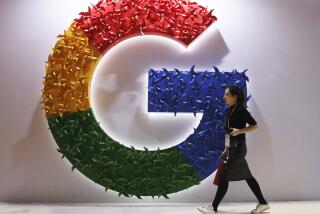Microsoft’s Conflict With AOL Intensifies
- Share via
In a high-tech version of Godzilla versus King Kong, AOL Time Warner Inc. and Microsoft Corp. are locked in an epic battle for the wallets of Internet consumers and the blessings of government officials.
In the end, the struggle may benefit technology users by leaving them with more products and services. But there also is the danger that consumers--and the rest of the industry--will get caught in the cross-fire of the two aggressive companies, both of which have tended to restrict choice rather than expand it.
“These two giants are engaged in the ultimate digital food fight,” said Jeff Chester, executive director of the Center for Digital Democracy, a Washington advocacy group. “The danger here is that they will divide up the world between them.”
The rivalry is heating up because of a second major shift in the Information Age’s central competitive arena. The hardware business, which includes IBM, as well as other firms that have vanished, was once where the big money was. Then the center of power changed to software, where Microsoft dominates, and now it is moving to services and communications, where AOL leads the pack.
As AOL fights to hold its territory, Microsoft is trying to break new ground with its scheduled introduction in October of Windows XP, its new operating system.
XP will come bundled with Microsoft’s instant-messaging program, its audio and video player and Passport, an identity authentication service that will enable users to do business at various Web sites with a single password. Passport is the first step in Microsoft’s .Net strategy for providing a multitude of Internet services according to individual preferences.
Not coincidentally, AOL provides many of the same services, and it views Windows XP and .Net as direct assaults on its core business. The company has committed tremendous resources toward at least slowing their deployment.
The multiple-front war is heating up as federal and state antitrust officials mull over their next move in their suit against Microsoft. The company, which lost a request Thursday for a rehearing at the appeals court level, will decide this week whether to ask the Supreme Court to overturn a June 28 ruling that it illegally maintained its desktop operating system monopoly. If it does not appeal, the case will go back to a district court judge for hearings on how Microsoft should be punished.
In the meantime, AOL and Microsoft are battling to maintain their dominant positions while trying to chip away at each’s other core strengths. The goals are different, but their strategies are remarkably similar.
Moving to Create Strategic Partnerships
Both firms are rushing to forge alliances, sometimes exclusively. The trend is forcing many potential allies of both to pick sides.
Starbucks, for example, has made Microsoft Passport the exclusive Web authentication service for its e-commerce site.
AOL recently said it would bolster its e-commerce presence by investing $100 million in Amazon.com Inc. AOL may be interested in Amazon’s one-click shopping for repeat customers, which Amazon has patented.
But the major battleground is the desktop of personal computers, particularly after Microsoft said last month that it would give computer makers more freedom to control what icons appear once Windows XP is launched.
Before the court ruling, Microsoft threatened to withhold Windows licenses from computer makers that modified the Windows desktop appearance. The change in policy came in response to the June 28 appeals court ruling that such practices are anti-competitive.
Now AOL is working feverishly to sew up deals with computer makers to promote as many of its offerings as possible. It reached an exclusive deal with Compaq Computer Corp. to put an AOL icon on the desktop and relegate Microsoft’s MSN icon to the start menu.
For computer makers, which have seen sales slip and profits plunge, the AOL-Microsoft rivalry has opened the door for much-needed revenue.
“Being in the hardware business is not an enviable position for anyone right now,” said Kevin Kyle, a marketing director at Houston-based Compaq, the No. 2 PC maker. “It’s been nice to have help from AOL.”
Since announcing the AOL deal, Compaq said, it has been deluged with requests from other companies willing to pay to reach Compaq’s customers. Kyle said the company planned to put a “handful” of icons in place, including paid links to Web sites.
“It opens up a source of additional revenue, and Lord knows they need every dollar they can get,” said analyst Rob Enderle of Giga Information Group.
But last week, Microsoft took steps to rein in some of the new freedoms it awarded computer makers, insisting that any computer company promoting AOL on the Windows XP desktop screen would have to put MSN in the same place.
Companies Invading Each Other’s Turf
More than ever, AOL and Microsoft are in direct competition over their key products, including Internet access, Web browsers, instant messaging, interactive television, Web authentication services and Web-based calendars.
“They both want to own the soul of the Internet consumer,” said Bill Whyman, president of Precursor Group, a consulting firm in Washington. “So they are both trying to control the key consumer applications, such as e-mail and chat.”
One of biggest threats to AOL is Microsoft’s MSN Explorer, a colorful, consumer-oriented Web browser that rips a page out of AOL’s playbook. MSN Explorer, which will be bundled into the new XP operating system, looks and feels a lot like AOL’s proprietary service, with one-click e-mail access, instant messaging, shopping, a music and video player and other features that traditionally have been packaged into AOL.
“MSN Explorer is the AOL killer,” said a lobbyist for a leading technology firm.
Microsoft’s new Messenger service is another worry for AOL, the current leader in instant messaging with 100 million users. Automatically installed in the XP operating system, Microsoft Messenger will allow one-click teleconferencing (for users with cameras) and the ability to quickly transfer or collaborate on files and applications. Two users may simultaneously view the same document on their screens and transfer it back and forth.
AOL’s efforts to invade Microsoft’s turf have been less successful, though they remain a threat.
The company toyed with the idea of developing an AOL PC with an operating system that would rival Windows, but decided such a strategy would be impractical.
Instead, it has been developing a variety of Internet appliances that do not rely on the Windows operating system. Last year, AOL and Gateway Inc. unveiled a nearly $500 Internet device that runs off of the Linux operating system.
In 1999, AOL bought Netscape Communications, whose Navigator Web browser provides the only real competition to Microsoft’s Internet Explorer. AOL’s contract to use Internet Explorer as its default Web browser (in exchange for an AOL icon on Windows) expired early this year, and negotiations to extend the agreement fell apart.
That gives AOL the freedom to make Netscape Navigator the default browser for its 30 million AOL subscribers. If all AOL users switched to Navigator, Microsoft Internet Explorer’s market share in the U.S. could drop as low as 70% from the current 86%, while Navigator’s share could double to 30%, according to WebSideStory, an Internet analysis company.
AOL has not said whether it plans to change browsers, but it is testing the idea with users.
Representatives Are on the Front Lines
AOL and Microsoft also are cranking up their propaganda machines. Each has designated a spokesman to respond to the almost daily barrage of charges.
At Microsoft, the chief spokesman is Vivek Varma, a former Democratic aide and attorney who previously worked for the company’s top in-house lawyer. His counterpart at AOL is John Buckley, who joined the company from Bob Dole’s 1996 presidential campaign.
AOL’s none-too-subtle public relations strategy is to label Microsoft a “convicted monopolist” as often as possible. Microsoft’s tact is to portray AOL as hypocritical for engaging in similar practices.
“The strategy for both is to focus on how big and bad the other one is, to paint the other as the leading monopolist,” said Blair Levin, analyst at Legg Mason Inc. in Washington.
The rivalry has crept into the companies’ marketing and advertising. Earlier this week, AOL Time Warner and Microsoft had dueling news releases about their digital photography products.
On Tuesday, AOL announced it was expanding its You’ve Got Pictures partnership with Eastman Kodak Co. The same day, Microsoft held a press conference in New York to show off the photo features of its new XP operating system.
Adding tension to the event was the fact that Kodak, which has partnered with Microsoft in the past, has been openly critical of XP’s photo features, which it says allows Microsoft to set up a tollbooth between Kodak and its customers.
Microsoft launched a $50-million campaign this spring to woo AOL subscribers to its MSN online service shortly after AOL announced that it would hike its rates 9% to $23.90 a month. And last week, a Microsoft-funded group ran an ad in Roll Call, a Capitol Hill newspaper, blasting AOL Time Warner for its heavy-handed lobbying.
Meanwhile, each company has dispatched lobbyists to whisper to legislators that the other is the greater threat to consumers.
AOL has pressed the Senate Judiciary Committee to hold hearings on the launch of Windows XP. Microsoft resisted, arguing that Congress should stay out because of the pending antitrust litigation.
AOL won that round, and hearings are likely this fall. But Microsoft is trying to make sure AOL also gets a turn on the hot seat.
And yet another front seems about to open.
By acquiring Time Warner, AOL became the second-largest cable operator in the U.S. Microsoft has made considerable investments in cable companies as well, including AT&T; Corp. and Comcast Corp. Now AOL and Microsoft are jockeying for more of the fat pipes that will connect Internet users to high-speed and potentially more costly services.
Last month, AOL opened exploratory talks about buying AT&T; Broadband, which is scrambling to avoid selling to Comcast, which made an unsolicited takeover offer.
A day after the talks were revealed, reports surfaced that another player might intervene to block the AOL offer. The potential spoiler? Microsoft.
More to Read
Inside the business of entertainment
The Wide Shot brings you news, analysis and insights on everything from streaming wars to production — and what it all means for the future.
You may occasionally receive promotional content from the Los Angeles Times.








